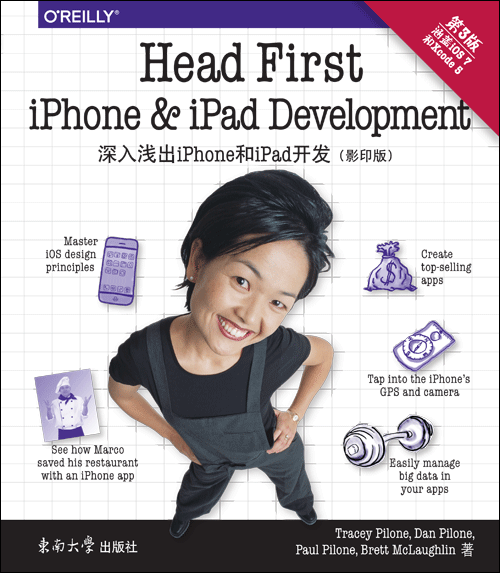深入浅出iPhone和iPad开发(第3版,影印版)
出版时间:2014年11月
页数:368
“《深入浅出iPhone和iPad开发》使用一种幽默的吸引人的甚至愉快的方法来学习iOS开发。这本书涵盖了诸多关键技术,包括Core Data甚至像界面设计这样的重要方面,其内容恰当且首屈一指。”
——Sean Murphy,iOS设计员和开发员
“《深入浅出iPhone和iPad开发》从基础开始讲解了iOS应用开发。该书的方法循序渐进且着重于视觉效果,非常适合于学习从基础到高级特性的整个iPhone和iPad应用开发。”
——Rich Rosen,软件开发者和《Mac OS X for Unix Geeks》的作者之一
你可以从这本书里学到什么?
假设你有一个杀手级的iPhone或者iPad应用的想法。你应该从哪儿着手?
《深入浅出iPhone和iPad开发》将帮助你瞬间搭建和运行你的第一个应用。你将快速了解如何使用iOS 7工具和Xcode 5,同时可以掌握Objective-C编程准则,从而让你的应用脱颖而出。这是一次完整的学习体验,你将创建吸引眼球、畅销的iOS应用。
这本书为何如此独特?
我们认为你的时间十分宝贵,没有必要浪费在理解新概念上。《深入浅出iPhone和iPad开发》基于神经生物学、认知科学和学习理论方面最新的研究成果,它使用了多种丰富生动的组织形式来适应你的大脑,而不是那种只会让人昏昏欲睡的长篇累牍。
——Sean Murphy,iOS设计员和开发员
“《深入浅出iPhone和iPad开发》从基础开始讲解了iOS应用开发。该书的方法循序渐进且着重于视觉效果,非常适合于学习从基础到高级特性的整个iPhone和iPad应用开发。”
——Rich Rosen,软件开发者和《Mac OS X for Unix Geeks》的作者之一
你可以从这本书里学到什么?
假设你有一个杀手级的iPhone或者iPad应用的想法。你应该从哪儿着手?
《深入浅出iPhone和iPad开发》将帮助你瞬间搭建和运行你的第一个应用。你将快速了解如何使用iOS 7工具和Xcode 5,同时可以掌握Objective-C编程准则,从而让你的应用脱颖而出。这是一次完整的学习体验,你将创建吸引眼球、畅销的iOS应用。
这本书为何如此独特?
我们认为你的时间十分宝贵,没有必要浪费在理解新概念上。《深入浅出iPhone和iPad开发》基于神经生物学、认知科学和学习理论方面最新的研究成果,它使用了多种丰富生动的组织形式来适应你的大脑,而不是那种只会让人昏昏欲睡的长篇累牍。
- Chapter 1: Getting Started: Getting mobile with iOS
- So you want to build an iOS app...
- Welcome to the Apple universe!
- iOS apps are written in Objective-C
- It all starts with the SDK
- Pin Xcode...you’re going to be here a lot
- Meet Sue, your new boss
- Xcode and Git...new best friends
- Xcode is the hub of your iOS project
- The iOS simulator
- Your code is stored in source files
- Code Editor, Hub...and debugging, too
- One iPhone, two iPhones, red iPhone, blue iPhone...
- Your iPhone Development toolbox
- Chapter 2: Basic iOS Patterns: Building from scratch
- iOS apps run full screen, but there’s a lot going on
- Model-View-Controller is a design pattern
- Get started with Xcode and Git
- Design time!
- Design time...redux
- Cosmetic changes are easy in Xcode
- You could code this if you’re into that kind of thing...
- iOS controls are more than skin deep
- You’ll create the action using the Xcode GUI editor
- Connect your controls to your actions
- So how do we get to that text?
- Properties handle creating getters and setters
- Create a property for that text field
- You connect your controls to outlets
- Twitter, the easy way...
- Your iOS Basics toolbox
- Chapter 3: Interlude: Syntax
- Classes: Interface and Implementation
- Header files describe the interface to your class
- Properties are about efficiency
- Message passing: How Objective-C gets around
- Speaking of messages....
- Your Syntax toolbox
- Chapter 4: Tables, Views, and Data: A table with a view
- Congratulations!
- SpinCity browsing app overview
- The way iOS apps work
- Using the touch screen....
- Hierarchical data—get out your table view
- We need to hook these views together...
- Three views in one template
- Use MVC to separate your concerns...
- Adding a new class
- Properties expose class attributes
- Data Access Objects hide low-level data access
- You’ve built your DAO!
- A table is a collection of cells
- Your View toolbox
- Chapter 5: Multiview Applications: It’s all about the details
- An app with a view...
- Table views don’t always look like...tables
- Change your UIViewController to a UITableView Controller
- Layout for the new detail view
- Layout your view within the storyboard
- Design the rest of the view dynamically
- Segues connect view controllers
- Connect your scenes in your storyboard
- Segues let you prepare for a new scene
- Update your prepareforSegue callback
- There’s an app a list for that
- Create a new property list
- You need to load each album from the plist
- Convert your data to plists in one easy step
- Your View toolbox
- Chapter 6: The Review Process, Design, and Devices: How to live with Apple
- It’s Apple’s world...you’re just living in it
- Device checking... it’s not optional
- Device checking case study: the camera
- iOS handles the heavy lifting
- Hmmm... supported device, missing feature
- The HIG helps, rather than hurting you
- You’ve already gotten used to the HIG...
- Design = look + feel
- iOS 7 Top 5
- More to think about: your iPad is not your iPhone
- Your Apple toolbox
- Chapter 7: Basic Core Data and Table View Cells: Reruns are hard to find
- This is your application
- This is your application on data
- Introducing Core Data
- ...and speaking of data
- The Gilligizer app
- Core Data starts with...data
- Core Data works with entities
- Core Data describes entities with a Managed Object Model
- Build your Show entity
- Our generated Show class matches our Managed Object Model
- NSManagedObject also implements the properties
- You have an object...now present it.
- Present each entity in Gilligizer
- Your Core Data toolbox
- Chapter 8: Implementing search with core data: Looking for info
- The app is working, but it’s limited...
- Use an NSFetchRequest to describe your search
- Let’s give it a shot...
- iOS 7 has Core Data and UIKit support for searching
- SearchDisplayController handles just about everything
- Use predicates for filtering data
- The NSFetchRequest predicate controls what data is returned
- It was a trick question...
- Your searching toolbox
- Chapter 9: Core data, mapkit, and core location: Finding a phone booth
- Everything old is cool new again
- An app, an iPad, and a phone booth
- iOS apps are read-only (well, kind of...)
- An iOS application structure defines where you can read and write data
- Enter... UIImagePicker
- Prompt the user with action sheets
- Where Who... are you? Where Who, who?
- Core Location can find you in a few ways
- Map Kit comes with every iOS device
- Annotations require a little more work finesse
- Fully implement the annotation protocol
- Your kit Toolbox
书名:深入浅出iPhone和iPad开发(第3版,影印版)
国内出版社:东南大学出版社
出版时间:2014年11月
页数:368
书号:978-7-5641-5003-7
原版书书名: Head First iPhone & iPad Development, third edition
原版书出版商:O'Reilly Media
购买选项
